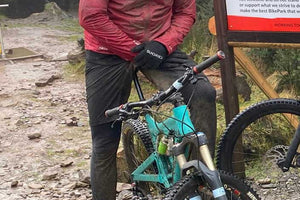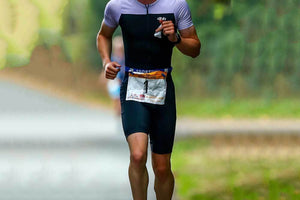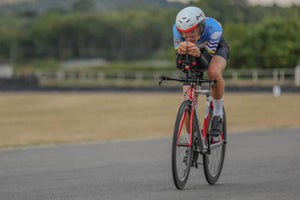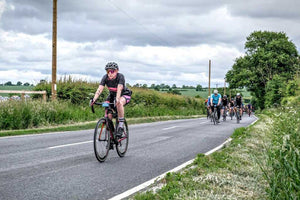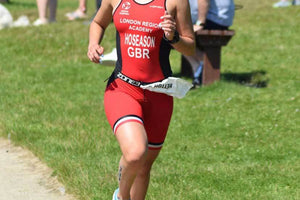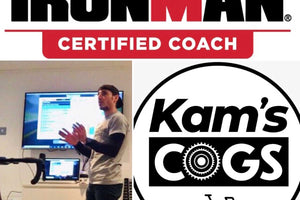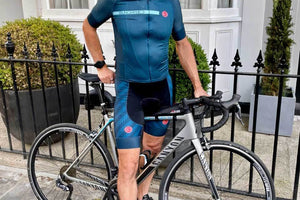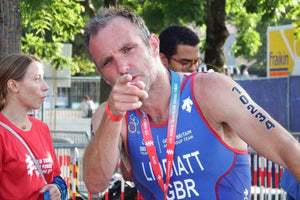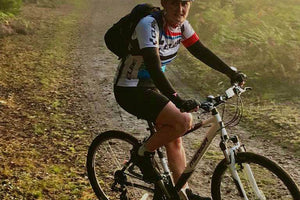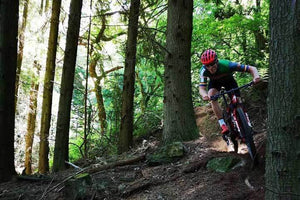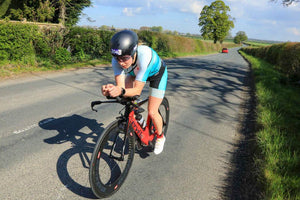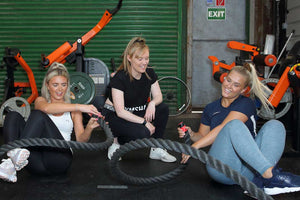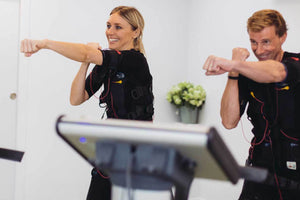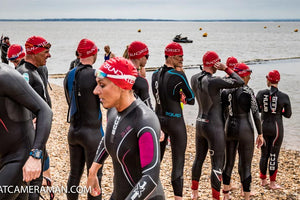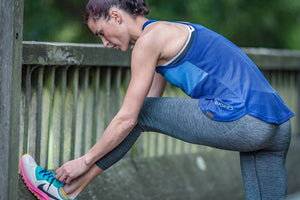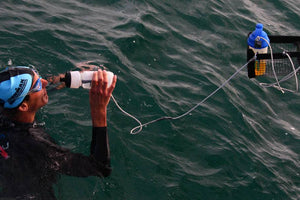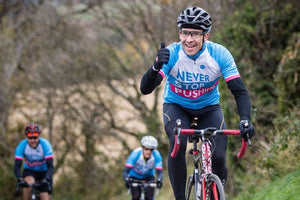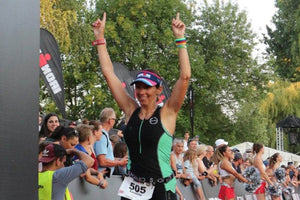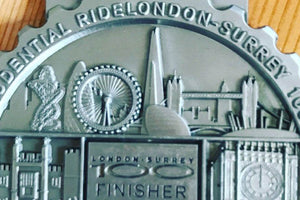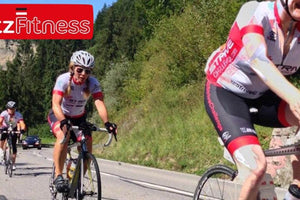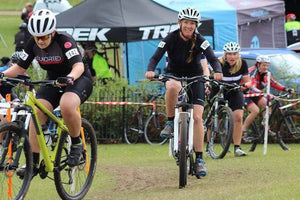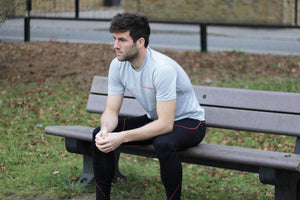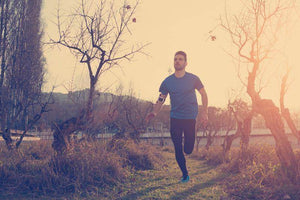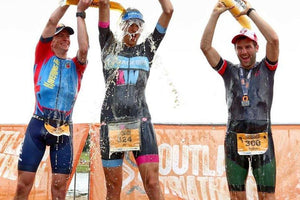Should You Slurp an Energy Gel on Your Ride? Let's Get Gelled Up!
1. Introduction: Gels: Your Pocket Rocket Fuel for Pedals?
Energy gels have become the go-to grub for endurance athletes, especially runners and cyclists, looking to keep the power going for ages. These little flavour pouches are like instant energy shots, perfect for scoffing on the move. For us cyclists, whose energy tanks can hit empty after about 90 minutes of graft, energy gels seem like a super handy way to stay topped up and avoid hitting the wall. This article is your guide to the world of energy gels for cycling, looking at what's in them, the good and not-so-good bits, how to use them like a pro, and what other options are out there. Think of it as your cheat sheet to making smart choices about fuelling your ride.
2. What's the Goo? Unpacking the Energy Gel
Energy gels are basically designed to give you a quick blast of carbohydrate energy, which is your body’s favourite fuel when you're pushing hard for a long time. They're usually packed with simple sugars like glucose and fructose, or easy-to-digest complex carbs like maltodextrin. For example, a standard GU Energy Gel (32g) gives you about 100 calories, almost all from 22 grams of carbs. These carbs, often a mix of maltodextrin and fructose, are chosen because they get absorbed super fast, giving you energy without causing a rumble in your tummy. They also often chuck in some sodium, an important electrolyte you lose when sweating, usually around 60mg per serving in GU gels, to help with hydration and getting those nutrients where they need to go.
The logic behind this is all about how your body works when you're cycling. When you're pedalling, especially at a decent pace, your muscles and liver use stored carbs (glycogen) as their main fuel. As these stores run low, you start to feel knackered, and your performance can take a nosedive. The simple sugars and maltodextrin in energy gels break down quickly and get into your bloodstream as glucose, which your working muscles can then use for energy. This quick fuel boost helps to refill your glycogen levels and keep your blood sugar steady, meaning you can keep going for longer. Some gels also add bits like branched-chain amino acids (BCAAs), which might help reduce feeling mentally tired and muscle damage, and caffeine, which is known to boost endurance and sharpen focus. However, the exact carb sources and extra bits can vary between brands, like the isotonic gels from SiS GO, which have 22g of maltodextrin and are designed to be taken without extra water. Other brands, like Never2, use a mix of water, maltodextrin, fructose, and other bits to get their specific energy delivery just right.
Want to close your eyes and digest this info? Listen to our deep dive podcast episode:
Or take a listen on YouTube to our Energy Gels deep dive
Table 1: What's in the Pouch? Typical Energy Gel Ingredients (Examples)
| Brand Name | Serving Size (g) | Calories | Total Carbohydrates (g) | Sugars (g) | Sodium (mg) | Caffeine (mg) | Key Ingredients |
|---|---|---|---|---|---|---|---|
| GU Energy Gel | 32 | 100 | 22 | 6 | 60 | 20-40 | Maltodextrin, Fructose, BCAAs |
| SiS GO Isotonic Gel | 60 | 87 | 22 | 0.6 | 1 | 0 | Maltodextrin |
| Clif Shot Energy Gel | 34 | 100 | 24 | 14 | ~25 | 25-50 | Maltodextrin, Cane Sugar |
| Honey Stinger Gel | 30 | 100 | 24 | 16 | ~30 | Varies | Organic Honey, Electrolytes |
| Maurten Gel 100 | 40 | 100 | 25 | N/A | N/A | 0/100 | Glucose, Fructose |
| Veloforte Energy Gel | 33 | 88 | 22 | N/A | N/A | 0/75 | Brown Rice Syrup, Maple Syrup, Dates |
| Carbs Fuel Original Gel | 55 | 200 | 50 | N/A | 105 | 0 | Maltodextrin, Sucrose, Fructose |
Note: Nutritional values can vary a tad depending on flavour.
3. The Good Stuff: Why Gels Can Be Your Mate on a Ride
Bringing energy gels into your cycling routine has some serious perks, mainly because they give you a quick and easy source of fuel. When you're cycling for a long time, your body's glycogen stores can get seriously depleted, leading to a drop in performance and that dreaded feeling of fatigue. Energy gels deliver a concentrated hit of carbs that are absorbed quickly, helping to top up those glycogen stores and keep your blood sugar levels stable. This sustained energy is key for endurance, letting you keep your pace and power going over longer distances and during tough bits of your ride.
Plus, energy gels are super convenient and easy to carry, making them ideal for cyclists on the go. They're small and light, so you can easily stash them in a jersey pocket or a little snack bag, making sure you've always got a quick energy fix without having to stop for a proper munch. This is especially handy during races or tough rides where you want to keep interruptions to a minimum. Compared to things like energy bars or proper food, energy gels are made to be absorbed quickly, meaning the carbs they contain are broken down and turned into energy much faster. This rapid energy delivery can be a lifesaver when you need an instant boost to get through a tough section or to maintain pace in a race. Some energy gels are also designed with extra benefits in mind, like including electrolytes to help with hydration by replacing minerals lost through sweat, or adding caffeine to give you a mental lift and improve focus during longer rides. Ultimately, using energy gels strategically can help you ride for longer, feel less tired, and generally boost your cycling performance.

4. The Not-So-Good Stuff: Things to Keep in Mind About Gels
Despite the good bits, using energy gels for cycling does come with a few potential downsides and things to think about. One of the main worries is the chance of getting an upset stomach. The concentrated nature of energy gels, especially their high sugar content and often processed ingredients, can be tricky for some people to digest, particularly when you're pushing hard. This can lead to stomach cramps, bloating, feeling sick, or even the runs. The risk of these issues can be worse if you don't drink enough water with your gel. Traditional energy gels usually need you to have a swig of water to help your body digest and absorb the concentrated carbs. Without enough liquid, the gel can just sit in your stomach, causing discomfort and not really giving you the energy boost you need.
Another thing to think about is the carbohydrate content and how much your body can actually take in. While carbs are essential for fuelling your ride, your body can only absorb so much per hour. If you're scoffing too many carbs from energy gels, especially if they're all from one source, beyond this limit (usually around 60 grams per hour, although dual-source options might let you go up to 90 grams), you won't get any extra energy and it could lead to tummy troubles. Also, some energy gels have artificial sweeteners, colours, additives, and preservatives, which might be a concern for cyclists who prefer more natural fuel. The taste and texture of energy gels can also be a bit of a downer for some, with some finding them too sweet or having a weird consistency. Finally, there's a chance you might get a bit reliant on energy gels, where you get used to the quick energy hit and forget about the importance of a balanced diet and proper fuelling with real food.
5. Gel Variety: A World of Options for Cyclists
The market is bursting with different energy gels designed to suit all sorts of cyclists and their preferences. One key difference is between traditional and isotonic gels. Traditional energy gels have a higher concentration of carbs and need you to drink water to help your body absorb them and avoid digestive issues. On the other hand, isotonic energy gels, like the SiS GO Isotonic Energy Gel, are made to have a similar concentration to your body fluids, so they get absorbed quickly without needing extra water. This can be really handy if you don't want to carry loads of water or during high-intensity bits where you might not be able to drink as often.
Another common type includes caffeine. Caffeinated gels, like some from GU and Veloforte, can give you an extra boost to endurance and help improve your mental focus and reaction time, especially towards the end of a long ride or race. The amount of caffeine can vary, so you can choose options that suit your tolerance and performance goals. Some energy gels also include electrolytes, like sodium and potassium, to help replace minerals lost through sweat and keep your hydration levels spot on. For cyclists doing really long or intense rides in hot conditions, these electrolyte-containing gels can be great for preventing cramps and dehydration.
What's more, some brands, like Veloforte, offer energy gels with a mix of glucose and fructose, which they get from natural sources. This combination is thought to improve how well you absorb carbs (up to 90g per hour) and might be easier on your stomach because it uses different pathways to get the nutrients in. For cyclists with sensitive tummies, options like Huma Chia Energy Gel, which uses natural ingredients, or Carbs Fuel Original Gel, which doesn't have gelling agents or artificial flavourings, might be better. The choice of energy gel really comes down to what you prefer, how well you digest them, how long and intense your ride is, and if you have any specific performance goals, like needing a caffeine kick or electrolyte boost.
Table 2: Comparing Different Types of Energy Gels
| Type of Gel | Key Features | Potential Benefits for Cyclists | Example Brands |
|---|---|---|---|
| Traditional | Higher carb concentration, needs water | Effective energy boost for those carrying water | GU Energy Gel, Clif Shot Energy Gel |
| Isotonic | Similar to body fluids, no extra water needed | Convenient, reduces risk of bloating | SiS GO Isotonic Energy Gel, 4Energy Gel |
| Caffeinated | Contains added caffeine | Enhanced endurance, improved focus and reaction time | GU Energy Gel, Veloforte Energy Gel |
| With Electrolytes | Includes sodium, potassium, and other minerals | Replenishes lost electrolytes, aids hydration | PNG Refuel Gel, Torq Energy Gel |
| Dual-Source Carb | Glucose-fructose mix | Maximised carb absorption, potentially gentler on stomach | Veloforte Energy Gel, Maurten Gel |
| Natural Ingredients | Made with real food sources | May be better for sensitive stomachs | Huma Chia Energy Gel, Honey Stinger Gel |
| High Carbohydrate | Contains a larger amount of carbs per gel | Fewer gels needed per hour for high carbohydrate intake | Nduranz Nrgy Unit Gel |
Note: Nutritional values can vary a tad depending on flavour.
6. Getting it Right: When and How to Use Gels for Cycling
To really get the benefits from energy gels, you need to think carefully about when and how you use them during your rides. A good rule of thumb is that energy gels are most useful for rides that last longer than 90 minutes, as this is when your body's initial energy stores usually start to run out. For shorter rides, especially if you've eaten well beforehand, you might not need them. However, for longer rides or high-intensity efforts, using gels strategically can help you keep your energy levels up and delay feeling tired.
It's often recommended to take your first gel around 60 to 90 minutes into your ride. This gives your body a chance to use its initial glycogen reserves before you start supplementing. After that, you should take gels at regular intervals, usually every 30 to 60 minutes, depending on how hard you're riding, how many carbs you need, and how your body reacts to the gels. Many experts suggest aiming for an intake of 30 to 60 grams of carbs per hour for moderate-intensity cycling, and up to 90 grams per hour during ultra-endurance events, which could mean taking one to three gels per hour depending on how many carbs are in them. Some cyclists also find it helpful to have a gel 15 to 30 minutes before starting a long or intense ride to top up their energy stores.
Proper hydration is super important when using energy gels, especially the traditional kind. It's generally recommended to have a few sips of water before and after taking a gel to help with digestion and absorption. Isotonic gels, though, are designed to be taken without extra water, which can be more convenient. It's really important to try out different brands, flavours, and timings during your training rides to see what works best for your tummy and energy needs. Race day or a big event is not the time to try a new fuel! Cyclists should also listen to their bodies and adjust their gel intake based on how they're feeling and performing. Energy gels should ideally be part of a bigger fuelling plan that might also include sports drinks, energy bars, or proper food, especially on longer rides.
7. Beyond the Goo: Other Ways to Fuel Your Ride
While energy gels are a handy and quick source of carbs, cyclists have other options for fuelling their rides. These include solid foods, energy drinks, and energy chews, each with its own advantages and disadvantages. Solid food options like bananas, dried fruits (like raisins, apricots, and dates), energy bars, rice cakes, and sandwiches can give you a more sustained release of energy and might be more appealing for some people, especially on longer, less intense rides. For example, bananas have natural sugars and potassium, while dried fruits are a concentrated source of carbs. There are also recipes for homemade energy-rich foods like banana French toast cakes and sweet potato pancake sandwiches if you fancy making your own.
Energy drinks, which usually have a mix of carbs and electrolytes, can be a good option for rides lasting 1.5 to 3 hours, giving you both hydration and fuel in liquid form. Some cyclists even make their own energy drinks using simple ingredients like sugar, salt, and water. Energy chews offer a similar carb hit to gels but in a solid, chewable form, allowing you to take them in smaller bits over time. The choice between energy gels and these other options often depends on how hard and how long your ride is, as well as what you prefer and how well you digest things. Energy gels are generally preferred for high-intensity efforts because they're absorbed quickly and easy to take, while solid foods might be better during longer, steadier rides where you've got more time to chew and digest. It's also common for cyclists to mix and match, using a combination of gels, drinks, and solid foods to meet their energy needs and avoid getting bored of one type of fuel on very long rides. Compared to energy gels, traditional snacks and proper food might take longer to digest, which could delay the energy boost.
8. Making it Personal: Tailoring Your Cycling Fuel Strategy
Deciding whether or not to use energy gels, and which type to go for, is really down to you and should be based on what you need, what you like, and how well your stomach handles them. Things like how long and how intense your ride is play a big part in how much fuel you'll need. Longer and harder rides will likely mean you need to take in more carbs, and the quick energy from gels could be really helpful here. On the other hand, for shorter, easier rides, your body's stored energy and maybe a small snack might be enough.
How sensitive your stomach is is a big thing to consider. If you get tummy trouble with certain energy gels, you might find alternatives with natural ingredients, a mix of carb sources, or isotonic formulations easier to handle. Experimenting during training is key to finding gels that sit well and give you the energy you need without causing any discomfort. Taste also matters, as the variety of flavours available can affect whether you're likely to use gels consistently throughout a ride. You should also think about whether you need extra bits like caffeine or electrolytes, based on what your ride demands and how your body reacts to these substances. Finally, practical things like your budget and whether you prefer natural versus processed ingredients can also influence what you choose to fuel your ride.
Table 3: Things to Think About When Personalising Your Gel Use
| Factor | Influence on Gel Use |
|---|---|
| Ride Duration | Longer rides (over 90 minutes) might benefit more from energy gels to top up glycogen. |
| Ride Intensity | High-intensity rides might need the quick energy boost that gels offer. |
| Digestive Sensitivity | People with sensitive stomachs might prefer isotonic gels or those with natural ingredients. |
| Taste Preferences | Choosing gels with flavours you like can make it easier to stick to your fuelling plan. |
| Need for Caffeine | Longer or tougher rides might benefit from caffeinated gels for an extra mental and physical boost. |
| Need for Electrolytes | Hot weather or very long rides might mean you need gels with electrolytes to help with hydration. |
| Budget | Energy gels can vary in price, which can affect how often and what type you use. |
| Preference for Natural Ingredients | Cyclists who prefer natural options might choose gels made with real food sources. |
9. Conclusion: Getting Gelled Up the Right Way
To sum it up, energy gels can be a great tool for cyclists wanting to get the best out of their rides, especially during longer and more intense efforts where the rapid delivery of concentrated carbs can help keep energy levels up and delay fatigue. Their convenience and portability make them a handy option for fuelling on the go. However, you need to be aware of potential downsides like stomach issues and the need for proper hydration, particularly with traditional gels. The wide range of energy gels available, including isotonic, caffeinated, and electrolyte-containing options, means cyclists can find products that suit their specific needs and preferences.
Top 10 Essential Bits to Know About Energy Gels for Cyclists:
-
Quick Energy, Handy Pouch:
- Energy gels are your portable, concentrated carb boost, designed for a rapid energy hit on the go. Think of 'em as pocket-sized power-ups.
-
Fuelling the Engine:
- Their main job? To quickly top up your depleted glycogen stores during long or hard rides, giving you that much-needed surge, especially on climbs or sprints.
-
Key Perks:
- Enjoy a rapid energy boost from fast-absorbing carbs (glucose, fructose, maltodextrin), ultimate handiness, and precise carb dosing (typically 20-30g per gel).
-
Added Extras:
- Many gels include electrolytes (sodium, potassium, magnesium) for hydration and cramp prevention, caffeine for mental sharpness, or dual-source carbs for better absorption.
-
Potential Drawbacks:
- Be aware of potential tummy troubles (nausea, bloating), the need for water (unless isotonic), and their limited nutritional profile beyond carbs.
-
The Energy Rollercoaster:
- The rapid sugar rush can lead to a quick energy spike followed by a slump. Plus, the taste and sticky texture can be a bit of a turn-off.
-
Carb Content Matters:
- Gel effectiveness varies. A 1:0.8 glucose-to-fructose ratio and maltodextrin can optimise absorption. Steer clear of gels with dodgy carbs.
-
Strategic Gel Use:
- Time your gels wisely (before you’re knackered), practice during training, aim for 30-60g carbs per hour, and always wash 'em down with water.
-
Beyond the Gel:
- Explore alternatives like energy bars, sports drinks, chews, proper food (bananas, dates), or homemade options, each with different absorption rates and practicality.
-
Performance Impact:
- Gels can significantly boost performance by providing immediate energy, but improper use can lead to gut issues. Personalised experimentation is key to finding your ideal gel strategy.





